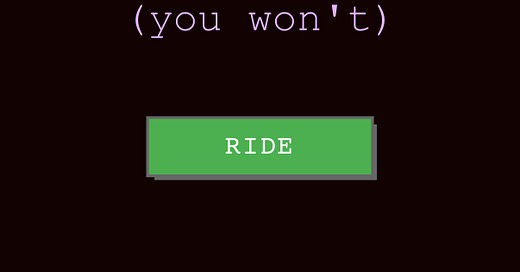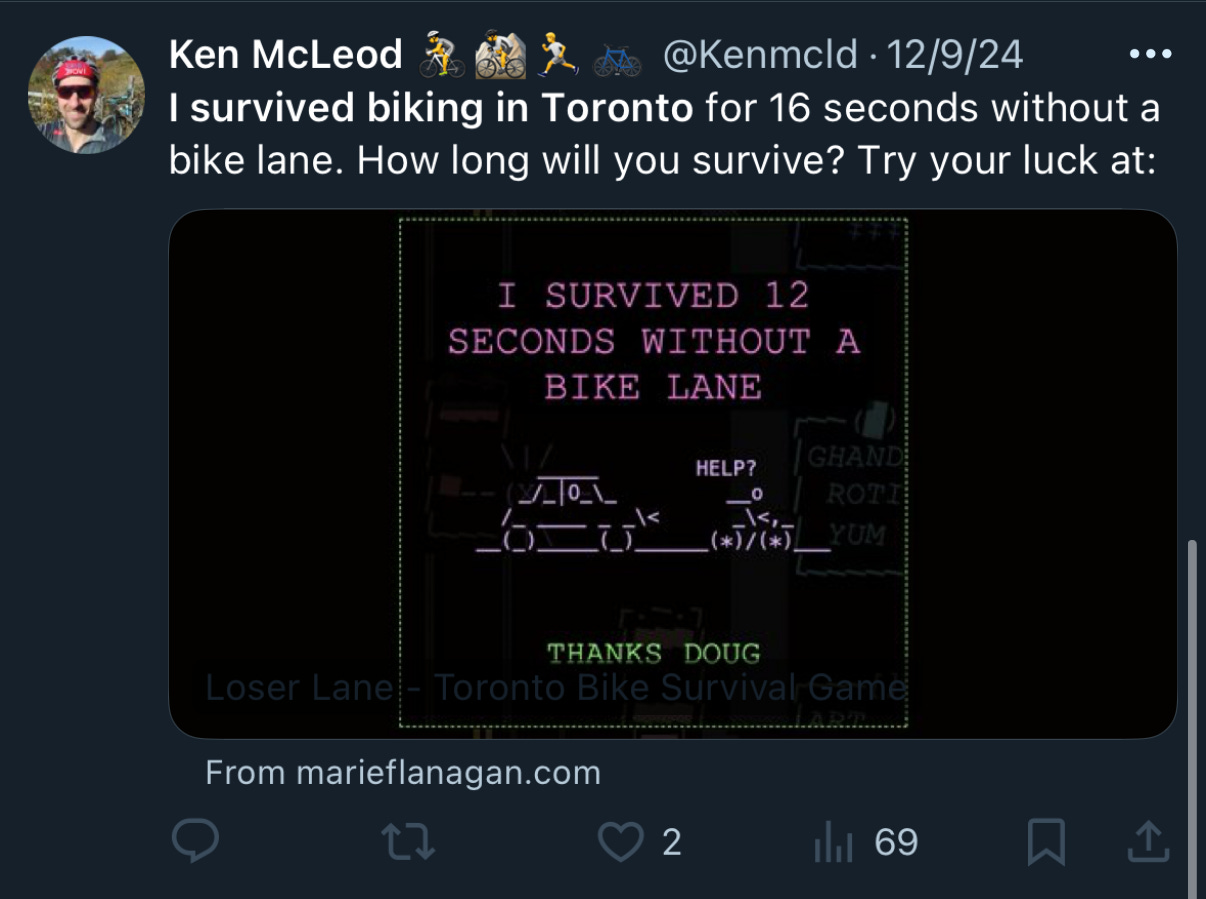A Review of "Loser Lane"
The game where bicyclist victimology, edge riding, and activism are features, not bugs.
A new game has “gone viral,” reports Outhouse Magazine’s Velo outlet.
It’s called “Loser Lane,” and it was developed by Canadian artist and activist Marie LeBlanc. It’s a web-based game that can be run on on both a standard computer using the keyboard arrow keys or via a smart phone or tablet by touching the screen. The graphics are basic and quirky, yet nostalgic for fans of old school video games.
The Superficial Rules of The Game
Loser Lane is simple: the player is a bicyclist, whose size is vastly exaggerated out of scale, on an urban street with both moving motor vehicles in the bicyclist’s same direction along with parked motor vehicles and pedestrians. The purpose of the game is for the bicyclist to survive as long as possible. However the game is intentionally coded to make that exceedingly difficult.
The bicyclist is placed by default in the door zone, but has the option to weave to the right temporarily into open parking spaces and the option to weave left (almost) into the general-use traffic lane. But she can’t move too far left, even if the coast is clear of cars because there is a set of streetcar rails, a common source of solo bicyclist crashes in cities where they’re installed, that runs parallel to her path. (That won’t stop the clowns at Streetsblog though.) If the bicyclist does move to the right and doesn’t move left in time, she’ll lose by colliding with the back of a parked car. In that sense it’s not entirely inaccurate as it mirrors what behavior legitimate cycling safety experts call “edge riding.” If she manages to avoid all those crashes, she’ll get doored.
The Real Rules of the Game
When the bicyclist loses, the game presents a screen with the cause of her death as well as how long the bicyclist survived in seconds. On the bottom is the text in all caps: THANKS DOUG
That’s followed by links to share the player’s survival time on various social media platforms.
That’s because Loser Lane was developed intentionally as a piece of activism against Doug Ford and his populist stance against Toronto’s bike lane projects. Toronto’s bike lane woes were covered in A Victim of Cancel Culture?, Avery Burdett’s Comments on Bicycle Lanes in Urban Areas,” and in Another Day, Another Preventable Bicyclist Fatality, Another Despicable Cluster B(ike) Activist Take.
In a statement provided to Momentum Mag, LeBlanc, described as a “game designer known for creating experimental games that explore the connections—and disconnections—between people,” said:
“A decade ago, I started calling the space between parked and moving cars in Toronto the ‘Loser Lane.’ It’s a dangerous game—dodging doors, weaving between traffic, and avoiding pedestrians while navigating streetcar tracks,” she says. “When I read the news about the removal of the bike lanes in Toronto, I felt afraid. I felt afraid for my loved ones who are going to get hit, inevitably, if the bike lanes that protect them are taken away. Then I read that the government added an amendment preventing cyclists from suing if they get injured or die because of the removed bike lanes. They know what they are doing.
The link at the bottom (FIGHT FOR YOUR BIKE LANES!) takes the player to Cycle Toronto’s website where there’s a link for activists to email the mayor and councillors of the city.
The form contains a pre-filled letter after the fields where the person provides their name, email, and street address1.
As someone who rides my bike in Toronto, I regularly encounter blocked bike lanes. Whether by parked cars or from construction chaos, too often I’ve been told that it’s no big deal and to “just go around”. My own safety often seems like an inconvenience.
Last week, a 24-year-old woman was killed by the driver of a large truck while she was trying to maneuver around a blocked bike lane. Her death is a tragic reminder that even along one of our busiest bikeways that sees thousands of cyclists a day, and in which one can travel almost exclusively on protected bike lanes, one unsafe segment can quickly turn one cyclist’s commute into a tragedy.
I am urging you to act now or else tragedies like the one on Thursday will continue to take place. Our cycling network is only as safe as its weakest link. Bikeways must be safe and passable by design for all ages and abilities (including women, children, and the elderly) or else only a small number of people will take up active transportation to help ease our worsening congestion woes.
Five people have been killed on our streets riding a bike in 2024. And none of those lives are less important than a construction project wrapping up a few days earlier than expected, or a delivery being made a few minutes faster. The convenience of a few does not outweigh the safety of everyone.
The status quo isn’t good enough. I am urging you to:
1. Ensure bikes lanes are not obstructed as a matter of ongoing public safety, not just periodic blitzes, and accelerate implementing automated enforcement parking programs and explore other reporting processes with an equity focused lens
2. Prioritize construction zone safety, including maintaining dedicated cycling facilities, eliminating road hazards, tougher penalties for failing to comply, and a creating a “mobility squad” to ensure obstacle-free travel on the city’s streets
3. Accelerate and expand our cycling network of connected bikeways to enable more people to feel safe to choose to ride a bike
My safety depends on it.
Unless there was another cyclist fatality involving a 24 year old woman and a dump truck blocking a bike lane within the last week that hasn’t yet made the news and cycling advocacy rounds, they’re likely talking about the one mentioned in “Another Day, Another Preventable Bicyclist Fatality, Another Despicable Cluster B(ike) Activist Take.”
Any bike fatality is a tragedy ripe for exploitation by bike lane activists but as these activists miss out on the potential lessons learned: bike lanes aren’t some sacred protected space, and that bicyclists need to acquire the skills to look and yield to other traffic when exiting them.
That’s sadly what this bicyclist did not do here. And that doesn’t dismiss the dump truck driver who was allegedly not legally parked at the location (which of course was in a “protected” bike lane) but that misses much of the point in an objective and sane world where motorists aren’t pitted as “oppressors” and bicyclists as eternal “victims,” with Noble Savior social justice minded bike lane activists as anointed “Rescuers.” Disempowering victimology bike lane activists, especially the Cluster B(ike) activists, view such life-saving suggestions as “victim blaming,” a label thrown around similar to the “climate denier” label.
Bumps in the Road
The game’s ability is further limited to same-direction mid-block riding, lacks turning and crossing movements by the motor vehicles and lacks intersections. This means the bicyclist in the game won’t be exposed to right hooks, left crosses, or drive outs which are all hazards wherever pedestrian style riding and edge riding are practiced - including in both standard on-road bike lanes and the so-called “protected” types.
Had it contained these items, perhaps dropped the streetcar tracks, and contained an option to signal and yield to motorists when moving left, it could have served as a valuable educational game on most common bike crash types, but alas, that would change the intent to something educational and empowering.

Some Roots of Victim-Based Bicycle Activism
John Forester, mentioned briefly in “The Ideological Capture of the League of American Bicyclists,” created the concept of "cyclist-inferiority superstition," as a foundation for explaining bike lane and protection activism. This superstition assumes that roads are inherently too dangerous for cyclists, that they do not belong on the roads as drivers of vehicles, but instead require specialized infrastructure. Ironically, this is what a lot of people who don’t ride bicycles think too except a chunk of these folks want bicyclists completely banned from public highways. Forester emphasized that for cyclists to be safe and ride successfully cyclists must view themselves as drivers of vehicles, fully capable of integrating into traffic rather than relegating themselves to segregated paths that often increase their vulnerability at intersections and other conflict points. The cyclist-inferiority belief instead reinforces a psychological dependency on external safety measures rather than empowering cyclists with the skills and confidence to navigate traffic effectively.
But there’s far more to it than that. Forester seldom dove into one of the main drivers of such a complex and given his famously disagreeable personality, it’s likely, if he were still alive today, he wouldn’t change his views.
Victim ideology has taken bicycle advocacy by storm and is part a broader cultural phenomenon as reflected in works such as Michael Shellenberger’s San Fransicko. Shellenberger’s bestseller critiques the de-civilization of cities in large part due to the amplification of victimhood as a means to gain moral leverage, a tool commonly used among the progressive activists who’ve also hijacked bicycling. It also argues victimhood culture undermines both individual agency and collective problem-solving. Per the title, Shellenberger focuses mainly on how this ideology has shaped San Francisco’s policies2 to prioritize the optics of care over actual solutions using examples of the homeless industrial complex, public open-air drug use, and criminal justice “reform.” So-called homeless “advocacy” and this flavor of bicycle advocacy overlap in the sense that the non-profits behind them seem more entrenched in padding their resumes and paychecks at the expense of actually solving problems. In the book, Shellenberger notes the concept of signaling victimhood as a means to gain from others, writing:
Victim signalers are more likely to boast of their victim status after being accused of discriminating against others, or of being privileged. And so-called virtuous victims, people who broadcast their morality, alongside their victimization, are more likely to gain resources from others, researchers find, and display Dark Triad personality traits, than victim signalers who did not signal their virtue.
Creating a victim-centric video game for activism purposes is certainly an example of such victim-signaling.
Furthermore,
‘s discussion on internalizing and Cluster B traits also points out how such narratives prioritize emotional victim-based appeals. Haltigan’s work, particularly his analysis of internalizing disorders and the influence of Cluster B traits on modern advocacy movements particularly via social media and internet use, compliments Shellenberger’s work.Haltigan labels this as ‘performative resistance art,’ which is quite fitting.
"Loser Lane" is just one example of a broader trend in bicycle advocacy: reliance on external narratives of blame rather than empowering individuals to address challenges effectively. The game while both clever and fun highlights certain edge-riding dangers to cyclists but ultimately frames bicyclists as helpless victims trapped in an oppressive oppressor-victim complex that can only be solved if everyone else chips in to build special safe spaces for bicycling. This narrative disregards the potential for empowering cyclists through education and skill-building.
Even though this form is intended for Toronto residents, any Canadian from outside Toronto can fill out the form as it allows not just the province of Ontario but for any of Canada’s provinces or territories.








Absolutely feel for bikes that need to share the road, but if you act like an asshole, you are defeating your own cause. Cars need to get by you safely, make some room, don't be that guy.
I totally support bikes sharing the road, but if you’re being reckless, you’re only hurting the cause. Drivers still need to pass safely—be considerate and share the space. And if you're biking, why not enjoy the ride with Spotify sem anúncios APK for uninterrupted music? https://spotifine.com/spotify-lite-mod-apk/